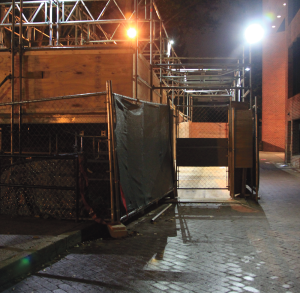
The winding, makeshift pathway set up during Northeast Triangle construction is poorly lit, leading to safety concerns from students.
Students have expressed concerns about poor lighting and overcrowding in the detour replacing the pathway in front of Reiss, which closed Oct. 13 due to construction of the Northeast Triangle Residence Hall.
Pedestrians must use an indirect pathway west of the Reiss Science Building until the central pathway, which connects Red Square to Henle Village, Darnall Hall and the Leavey Bridge in the north of campus, reopens after the construction project is completed in summer 2016.
The indirect pathway includes twists and turns that prevent those traversing it from seeing who is walking both in front of and behind them, and it is poorly lit at night, students said.
“We need more lighting [in the detour]. Normally on the weekends I will walk home alone, but on Saturday [night] I was at Village B and I wouldn’t walk home alone,” said Emily DeMaio (NHS ’17), who lives in Henle Village, which can only be reached by the makeshift route when coming from the front of campus.
DeMaio also said that she was concerned about the mesh linings that are on the fences in the construction site.
“Some of the fences have that mesh so that we don’t have to see the construction, but I’d really prefer it to be see-through,” DeMaio said. “Before the Reiss walkway was closed, and I was walking through there, there were construction workers and it scared me because I heard voices from behind the fence and then someone came out and I jumped, because it was five in the morning and I was alone.”
Kathleen Reilly (SFS ’17), a Henle resident, said that she is also concerned about walking through the detour at night.
“I think the section of the path between the Intercultural Center arch and the front of Reiss is the most poorly lit and also the most remote [place on campus],” Reilly wrote in an email. “I am always especially aware while walking in that section.”
Reilly said that although some of the sidewalks in the Georgetown neighborhood have the same level of lighting at night, poor lighting on campus is of particular concern.
“I’m more likely to be walking by myself, back from a nighttime meeting or whatever, on campus than in the neighborhood,” Reilly said.
Vice President for Planning and Facilities Management Robin Morey said that construction workers will add lights to the pathway by the end of the week, making it easier for students to safely navigate to the pathway at night.
Although the closure of the pathway has created safety concerns, Morey said that the path was blocked off in order to protect students from different safety concerns during construction.
“We tried to keep that pathway open but with the overhead construction in the construction site, we had to close it for construction logistics and student safety,” Morey said.
Construction plans for Northeast Triangle also include alterations to the pathway, widening it to the east of Reiss and making it more wheelchair accessible. Morey said that his office has not heard many complaints about the construction from students.
“Most students are understanding that this will improve the community and the campus in the long run and that this is just a short-term inconvenience,” Morey said.
Morey expressed that Georgetown’s ultimate goal in these developments is to increase pedestrian traffic and student presence on the north side of campus.
“We are trying to improve the nature of pedestrians on campus because I don’t think Georgetown is the most pedestrian-friendly campus,” Morey said. “We have gotten complaints that there is less of an overall student body population on the north side of campus where Henle Village and Darnall Hall are. The construction will add more people and more vibrancy to that side of campus.”
Darnall Hall resident Mia Lopez-Zubiri (COL ’18) said that in an effort to establish an inclusive environment for future residents of Darnall and Henle, the construction has further segregated current residents of those buildings, and off-campus residents of Burleith, from the rest of campus.
“The construction is inconvenient because it cuts off our main route to the center of the school,” Lopez-Zubiri said. “It is difficult to get to the center of the school because we have to take a longer route. We’re completely cut off from the rest of the school so it has isolated Darnall even more than it already was.”




















